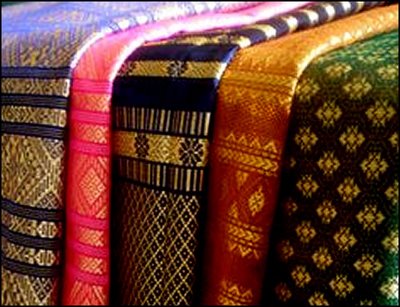
Songket is a fabric that belongs to the brocade family of textiles. It is hand-woven in silk or cotton, and intricately patterned with gold or silver threads. The metallic threads stand out against the background cloth to create a shimmering effect. In the weaving process the metallic threads are inserted in between the silk or cotton weft (latitudinal) threads. The term songket comes from the Malay/Indonesian word sungkit, which means "to hook". It has something to do with the method of songket making; to hook and pick a group of threads, and then slip the gold threads in it.[1] The word menyongket means ‘to embroider with gold or silver threads’. Songket is a luxury product traditionally worn during ceremonial occasions as sarong, shoulder cloths or head ties. Tanjak or Songket headdresses were worn at the courts of the Malay Sultanates.[2] Traditionally Muslim women and adolescent girls wove songket; "some boys and men are also weaving today".[3] Traditionally-patterned Sumatran textiles embody a system of interpretable emblems.
In Indonesia, songket is produced in Sumatra, Kalimantan, Bali, Sulawesi, Lombok and Sumbawa. In Sumatra the famous songket production centers is in Minangkabau area, West Sumatra, and Palembang, South Sumatra. In Bali, songket production villages can be found in Klungkung regency, especially at Sidemen and Gelgel village. While in the neighboring island of Lombok, the Sukarara village in Jonggat district, Central Lombok regency, is famous for songket making.[4] Outside of Indonesia, further production areas include the east coast of the Malay Peninsula and Brunei.[5] Songket weaving is historically associated with areas of Malay settlement, and the production techniques could have been introduced by Arab and Indian merchants. Historically, production was located in politically significant kingdoms because of the high cost of materials; the gold thread used was originally wound with real gold leaf.[5]

No comments:
Post a Comment